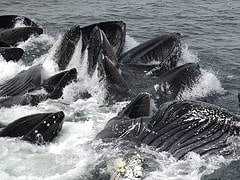The cetaceans (whales, dolphins and porpoises) are descendants of land-living mammals. There are some evidences that confirm this fact: their need to breathe air from the surface; the bones of their fins that resemble the jointed hands of land mammals; and the vertical movement of their spines, a common characteristic of a running mammal rather than the horizontal movement of fishes.
The traditional theory of cetacean evolution was that whales were related to the Mesonychids, an extinct order of carnivorous ungulates (hoofed animals), which looked rather like wolves with hooves and were a sister group of Artiodactyls.
However, since the early 1990s analysis of a wide variety of protein and DNA sequence data consistently indicated that whales should be included among Artiodactyls. Most probably they belong to a sister group of Hippopotamids. In other words, the proto-whales were former artiodactyls that kept typical features of their mesonychid ancestry (such as triangular teeth that modern artiodactyls have already lost).
The Pakicetids were hoofed-mammals that are sometimes classified as the earliest whales. They lived in the early Eocene, around 53 million years ago. They looked rather like dogs with hoofed feet and long, thick tails. They have been linked to whales by their ears: the structure of the auditory bulla is formed from the ectotympanic bone only. The shape of the ear region in Pakicetus is highly unusual and only resembles the skulls of whales.
The most remarkable of the recent discoveries has been the Ambulocetus, which looked like a three-meter long mammalian crocodile. Ambulocetus was clearly amphibious, as its back legs were better adapted for swimming than for walking on land, and it probably swam by vertically undulating its back, as otters, seals and whales do. Smaller cousins of the Ambulocetus was the Remingtonocetid family, which had longer snouts, and were slightly better adapted for underwater life. In both groups, the nasal openings were at the tip of the snout, like in land-mammals.
Known Protocetids had large fore and hindlimbs that could support their body on land, and it is likely that they lived in the sea and on land. It is unclear at present whether Protocetids had the horizontal tail fin of modern cetaceans. However, what is clear, is that they were more adapted to an aquatic life-style. The nasal openings are now halfway up the snout; a first step towards the telescoped condition in modern whales.

Cetacean evolution
Basilosaurus and Dorudon lived around 38 million years ago, and were fully recognizable whales entirely living in the ocean. Basilosaurus was as big as the larger modern whales.
Although they look very much like modern whales, basilosaurids and dorudontids lacked the ‘melon organ‘ that allows their descendants to use echolocation as effectively as modern whales. They had small brains; this suggests they were solitary and didn’t have a complex social structure. Basilosaurus had two tiny but well-formed hind legs which were probably used as claspers when mating; they are a small reminder of their ancestors’ lives. Interestingly, the pelvic bones associated with these hind limbs were no longer connected to the vertebral column as it was in protocetids.
Squalodon lived from the early middle Oligocene to the middle Miocene, around 33-14 million years ago. Skulls of Squalodon show evidence of the first hypothesized appearance of echolocation.
During the early Miocene, echolocation developed in its modern form. Early dolphins including Kentriodon and Hadrodelphis, were from small to medium-sized toothed cetaceans with largely symmetrical skulls, and thought likely to include ancestors of some modern species. Kentriodontines ate small fish and other nectonic organisms; they are thought to have been active echolocators, and might have formed schools.
Today, the whale hind parts are internal and reduced, and they serve as anchor for the muscles of the genitalia. Occasionally, the genes that code for longer extremities cause a modern whale to develop miniature legs.
Modern dolphin skeletons have two small, rod-shaped pelvic bones thought to be vestigial hind limbs. In October 2006 an unusual Bottlenose Dolphin was captured in Japan; it had small fins on each side of its genital slit which scientists believe to be a more pronounced development of these vestigial hind limbs.
